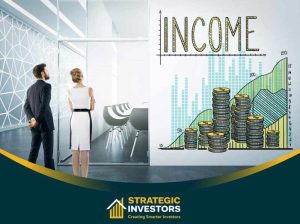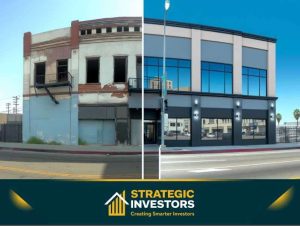
Considering commercial property as an investment? Discover the potential for higher yields and the importance of market insight to navigate associated risks.
Without the fluff, this guide offers you a clear view of the pros and cons, strategies for success, and the impact of economic cycles on commercial real estate.
We explain what draws savvy investors to this asset class and how it could fit into your financial plans.
Key Takeaways
- Commercial property investment offers higher potential rental yields, numerous tax incentives, and can serve as an inflation hedge when added to an investment portfolio.
- Investors need to understand market trends, identify high-growth areas, and be well-informed about economic conditions to make strategic investment decisions in commercial real estate.
- While commercial property investment can lead to significant returns, it also comes with risks such as economic sensitivity, longer vacancy periods, and higher repair costs, requiring strategic diversification and asset management.
Exploring the Appeal of Commercial Property Investment
 The appeal of commercial property investment is multifold. From potentially higher rental income compared to residential real estate to the numerous tax incentives, commercial properties offer promising returns.
The appeal of commercial property investment is multifold. From potentially higher rental income compared to residential real estate to the numerous tax incentives, commercial properties offer promising returns.
Moreover, adding commercial real estate to your investment portfolio is a strategic move, providing a hedge against inflation and contributing to long-term financial stability.
Attractive Rental Yields
Commercial properties typically offer higher rental yields, ranging between 5-8%, compared to their residential counterparts. This income potential is generally due to:
- Higher rents charged to businesses
- Longer lease terms
- Lower vacancy rates
- Potential for capital appreciation
All of these factors make Australia commercial property a lucrative investment avenue.
Tax Incentives for Investors
Investing in commercial real estate comes with distinct tax advantages. Investors can claim depreciation, enjoy GST credits on related expenses, and even benefit from government incentives for sustainable solutions. These incentives not only reduce the financial burden but also attract sustainability-conscious tenants.
Portfolio Diversification Benefits
Diversifying your investment portfolio with commercial real estate can act as a buffer against market volatility and potential losses from other investments. Optimizing returns and protecting your investments from specific market conditions can be achieved by diversifying your commercial properties across various types and geographic locations.
Navigating the Commercial Property Market
 Navigating the commercial property market requires:
Navigating the commercial property market requires:
- A deep understanding of market trends
- The ability to identify high-growth areas
- Insight into supply and demand dynamics
- Economic projections
This empowers you to make informed investment decisions and seize emerging opportunities.
Understanding Market Trends
Market trends play a crucial role in the profitability of commercial real estate investments. Some key trends to consider include:
- The rise of e-commerce, which has increased the demand for industrial and logistics spaces in the commercial market
- Economic conditions such as interest rates, inflation, and employment levels, which can influence the market
- Shifts in consumer behavior and preferences, which can impact the demand for different types of commercial properties
Having a keen understanding of these trends can help you make strategic investment decisions.
Identifying High-Growth Areas
Identifying high-growth areas in commercial property investment involves considering factors like the environmental performance, the potential for expanding available floor space, and properties offering essential services.
Additionally, the location of retail investments near key retailers can ensure continuous tenant occupancy and support property value growth.
The Mechanics of Commercial Property Investing
 Commercial property investment entails a grasp of the process mechanics, encompassing the selection of an appropriate property, acquisition of financing, and comprehension of lease agreements. Identifying profitable investments and mitigating potential risks, like initiating with a leased property for immediate rental income, is crucial.
Commercial property investment entails a grasp of the process mechanics, encompassing the selection of an appropriate property, acquisition of financing, and comprehension of lease agreements. Identifying profitable investments and mitigating potential risks, like initiating with a leased property for immediate rental income, is crucial.Selecting the Right Property
Selecting the right property is a crucial part of commercial property investment. Factors such as location, the condition of the property, and the tenant’s occupancy history play a major role in the property’s financial stability. Moreover, the value of a commercial property is closely tied to its potential for generating rental income, making thorough research and negotiation vital for successful investment.
Financing Your Commercial Investment
Grasping the lending landscape is paramount for financing your commercial property investment. Here are some key steps to consider:
- Plan your finances carefully, as commercial property loans require a significant contribution from borrowers and often have higher interest rates than residential loans.
- Consider leveraging equity from other investments to help fund your commercial property purchase.
- Engage a mortgage broker who specializes in commercial properties to assist you throughout the application process.
By following these steps, you can navigate the commercial property loan process more effectively.
Lease Agreements and Tenant Relations
In commercial property investing, comprehending lease agreements and fostering positive tenant relations hold significant importance. Commercial leases are more complex than residential ones and require detailed financial responsibilities from tenants.
Moreover, building strong tenant relationships through understanding their unique needs and addressing maintenance concerns proactively can ensure a stable income stream.
Risks and Rewards: A Balanced View
 While commercial property investments can offer significant returns, they are also associated with certain risks. From sensitivity to economic downturns to longer vacancy periods between tenancies, investors need to be aware of these potential challenges.
While commercial property investments can offer significant returns, they are also associated with certain risks. From sensitivity to economic downturns to longer vacancy periods between tenancies, investors need to be aware of these potential challenges.
However, diversification within the commercial real estate sector and investing in properties with multiple tenants can help mitigate these risks and enhance the potential for long-term growth.
Potential Risks Involved
Investing in commercial real estate involves certain risks, including:
- The value of commercial properties is often more sensitive to economic downturns than residential properties, with retail spaces being particularly affected.
- Longer vacancy periods between tenancies.
- Higher costs of repairs.
- Valuation loss.
A successful commercial property investment hinges on comprehending these risks.
Navigating Economic Cycles
Insight into real estate market cycles and adaptable strategies aid investors in navigating economic cycles in commercial property investment. During recessions, investors can acquire high-quality commercial properties at lower prices, leading to long-term rental income and capital appreciation.
A balanced portfolio that includes both specialization and diversification can further help endure sector-specific challenges and market shifts.
Commercial vs Residential Real Estate Investments
 Commercial and residential real estate investments have distinct differences in aspects like lease structure, tenant profiles, and investment strategies. While commercial investments focus on generating cash flow with higher rental yields and longer-term leases, residential property investments in the residential market can be more accessible due to lower entry costs and cater to various strategies such as negative gearing or capital growth.
Commercial and residential real estate investments have distinct differences in aspects like lease structure, tenant profiles, and investment strategies. While commercial investments focus on generating cash flow with higher rental yields and longer-term leases, residential property investments in the residential market can be more accessible due to lower entry costs and cater to various strategies such as negative gearing or capital growth.Lease Structure and Duration
Commercial leases typically extend for several years and are legally binding for the full period, significantly longer than residential leases which are often for 6 to 24 months. Moreover, commercial leases are less regulated, allowing more flexibility in terms and conditions.
Before embarking on commercial property investment, it’s vital to understand these differences.
Tenant Profile and Management
Tenant profiles in commercial properties are usually businesses, corporations, or organizations with different needs compared to residential tenants who are more likely to be individuals or families. This variation also reflects in the management of tenants. Commercial property management requires maintaining relationships with business tenants to secure lease renewals, unlike residential property management which involves more day-to-day maintenance and direct tenant interactions.
Building a Robust Commercial Investment Portfolio
 A robust commercial investment portfolio requires strategic asset allocation and adept management of various properties. By investing in a range of commercial property types and locations, you create a diversified portfolio, reducing the impact of a downturn in any single market sector.
A robust commercial investment portfolio requires strategic asset allocation and adept management of various properties. By investing in a range of commercial property types and locations, you create a diversified portfolio, reducing the impact of a downturn in any single market sector.
Moreover, the value of your portfolio and acquisition of high-quality tenants heavily relies on proactive asset management within the chosen asset class.
Strategic Asset Allocation
Strategic asset allocation in commercial property investment requires in-depth knowledge of different real estate sectors and aligning investment choices with financial objectives. A diversified investment strategy across various commercial property types and locations can steady returns and mitigate risks from market volatility or downturns in specific sectors.
Managing Multiple Properties
When it comes to managing multiple commercial properties, efficient property management is key. This involves:
- Maintaining the value of your real estate portfolio
- Securing high-quality tenants
- Optimizing operations through the implementation of technology and maintenance systems.
Enhancing Property Value and Maximizing Capital Growth
 A major aspect of commercial property investment is the enhancement of your commercial properties’ value and maximization of capital growth. This involves renovating properties, modernizing them, and implementing proactive asset management strategies. From updating fixtures to introducing energy-efficient features, these measures can significantly increase property value and make your properties more attractive to high-caliber tenants.
A major aspect of commercial property investment is the enhancement of your commercial properties’ value and maximization of capital growth. This involves renovating properties, modernizing them, and implementing proactive asset management strategies. From updating fixtures to introducing energy-efficient features, these measures can significantly increase property value and make your properties more attractive to high-caliber tenants.Renovation and Modernization
Renovating and modernizing your commercial properties can significantly increase their market value. This includes updating fixtures and fittings, refreshing interior paint, and introducing open-plan layouts. Additionally, focusing on safety and accessibility can boost the property’s attractiveness to potential tenants.
Proactive Asset Management
Proactive asset management is integral to enhancing property value and maximizing capital growth. This involves:
- Streamlining operations for better control over assets
- Training and development of contractors for effective property management
- Ensuring regular rental increases for long-term financial stability.
Summary
Commercial property investment offers promising returns and the opportunity for portfolio diversification. Despite the associated risks, strategic asset allocation, effective property management, and understanding the nuances of the commercial property market can lead to long-term financial stability and growth. As the journey into commercial property investment continues, remember that the key to success lies in understanding market trends, identifying high-growth areas, and building robust relationships with tenants.
Frequently Asked Questions














